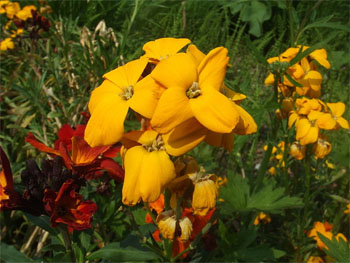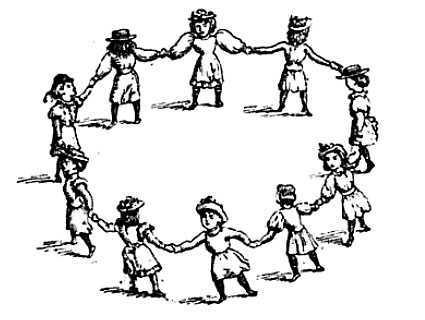Wall Flowers
Wallflowers are wildflowers in Ireland.

Wall Flowers
Circle Dance
Wallflowers, wallflowers,
Growing up so high,
We're pretty mermaids
And we shall not die.
Except for (girl's name),
She's the only one.
Turn her around, turn her around
So she cannot face the sun.
Notes
Seamus wrote, "Here is another version of the 'Wallflowers' song - game. Provided by my mother Teresa O'Brien.
Played in county Laois Ireland in the mid-1950s.
Wallflowers, wallflowers growing up so high.
Were all pretty maidens.
We all have to die.
Except (Girls name).
She is the only one.
Chopper chip
Chopper chip
Turn your face to the wall again.
Best regards,
Seamus O'Brien."
*****
Here's another version:
Wall flowers, wall flowers,
Growing up so high,
He had the measles
He'll never ever die.
*****
Here's another version as submitted by Miss H. E. Harvey of Howth, Dublin to "The Traditional Games of England, Scotland, and Ireland" (1898) edited by Alice Bertha Gomme:
Wall-flowers, wall-flowers,
Growin' up so high,
Neither me nor my baby
Shall ever wish to die,
Especially [girl's name],
she's the prettiest flower.
She can dance, and she can sing,
and she can tell the hour,
With her wee-waw, wy-waw,
Turn her face to the wall.
(Or "Turn your back to all the game.")
Game Instructions
The children form a ring by joining hands. They all dance slowly round, singing the words. When the one child is named by the ring she turns round, so that her face is turned to the outside of the ring and her back inside. She still clasps hands with those on either side of her, and dances or walks round with them. This is continued until all the players have turned and are facing outwards.


Thanks!
Thanks and Acknowledgements
Thanks to Seamus and Teresa O'Brien for sharing their version of this song!
Photo from Wikipedia. Diagram of how to play the game comes from "The Traditional Games of England, Scotland, and Ireland" (1898) edited by Alice Bertha Gomme.

























